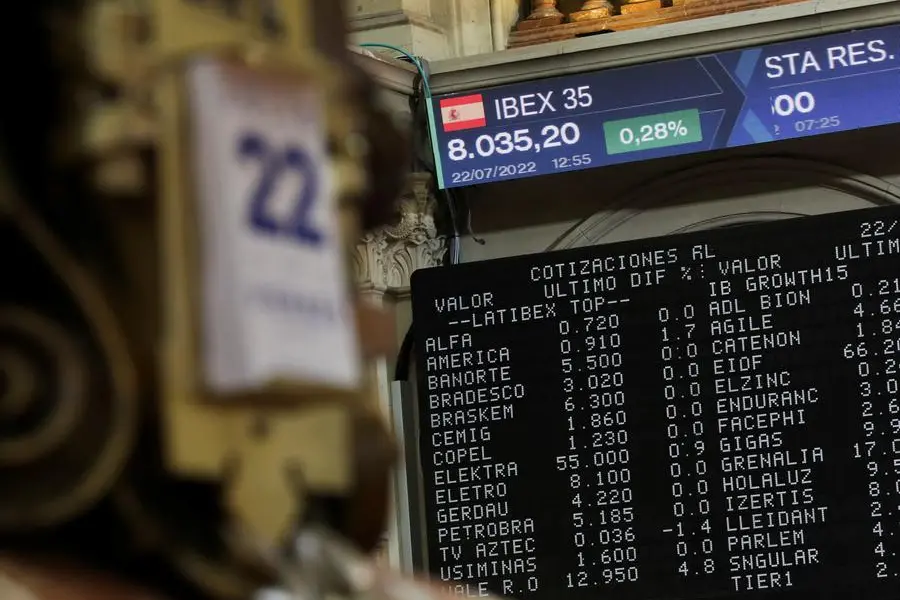PHOTO
LONDON - After more than a decade of underperformance, European stocks racing ahead of Wall Street peers still requires a double take - but some think we may need to get used to it.
In all the hubbub about inflation, interest rates, banks and recession, the most eye-catching move of the week was probably the bluest of Europe's blue-chip stock indexes hitting 22-year highs.
That exceeds the 2007 peak seen just before the financial crash 15 years ago and leaves the STOXX Europe 50 - a Europe-wide index that includes British and Swiss big caps as well as euro zone stocks - clocking its best levels since the euro first hit the streets in 2001.
France's CAC40 - driven by surging luxury goods stocks such as LVMH, L'Oreal and Hermes that benefit from China's reopening - went one better and notched a new record high.
Although the main euro indexes already did better than the U.S. benchmark S&P500 during a dire 2022 for all bourses, this year is different as investors move tentatively back into stocks more generally - but with different priorities to the immediate post-pandemic boom or even the past decade.
The most recent global fund manager survey by Bank of America still had a net 27% of respondents underweight equities in March - two standard deviations below historical averages. But at the same time they were more bullish on euro zone versus U.S. stocks than at any time since 2017.
Over the past 12 months, the STOXX Europe 50 and CAC40 have outstripped the S&P 500 by 16% and 24%, respectively, in dollar terms and the euro stocks 600 has been ahead by almost 17%. And they are all 6-12% ahead of the S&P 500 so far in 2023.
Aside from the macro relief of the euro zone avoiding a winter recession - as warm weather defused the Ukraine-related energy shock - several other factors are at work.
Underweight funds are returning rather gingerly to equity following 2022's rout and many are desperately seeking "value" in regions priced more cheaply than what's still considered to be historically expensive Wall St indices.
MSCI's Europe index, for example, still trades more than a point below its average historic valuation - with the index priced at less than 13 times its 12-month forward earnings. At more than 18 times, by contrast, MSCI USA still trades more than 2 points above its equivalent.
"The risk factor that had been associated with holding European shares is diminishing and this is allowing investment decisions to be made based more on fair value plays," noted Equiti Capital economist Stuart Cole.
DEFENSIVE VALUE
But beyond the historical value play, persistent uncertainty about global growth and earnings outlooks also means there is a preference by many asset managers for defensive "recession- proof" or "quality" big-cap stocks with decent dividends.
And on that score Europe-wide indexes start to outshine what for years was seen as the unassailable leadership of U.S. Big Tech.
The top sectoral weighting in the STOXX Europe 50, for example, is healthcare - at almost 23%. The top weighting in the S&P 500 is information technology at 26%, while financials dominate the narrower Dow Jones Industrial Average with a 20% share of that index.
With British-based stocks the biggest country weighting in the STOXX Europe index at 26%, the other top four sectors in the index include the food, beverages and tobacco grouping, consumer products, industrial goods and energy.
And at 3.2%, the dividend yield on that index is twice that of the S&P 500 and higher than the 2.3% on the Dow Jones.
While some may see this as yet another seasonal and temporary fad as markets churn and asset managers rotate from theme to theme, others argue a more durable shift is afoot.
The geopolitical and global trade fragmentation of the past three years, with the prospect of "reshoring" of manufacturing and a remapping of domestic supply chains, all underline a longer-term rethink of production over intellectual property, some argue.
Or as one hedge fund manager put it recently: "Stuff, rather than intangibles, is back."
And finally there is the currency play - where the falling dollar is making European assets more attractive to U.S. investors and the related transatlantic flow reinforces that exchange rate move into the bargain.
The dollar peaked late last year against most European currencies as the Federal Reserve raced to ratchet up interest rates. But it has retreated precipitously since as the Fed campaign nears its likely end point next month.
The euro hit its highest level in more than a year this week, sterling its highest in 10 months and the Swiss franc the highest in two years.
Can that continue? Some think the slide in the dollar index of some 12% since last September is barely half of the whole move.
Stephen Jen at Eurizon SLJ thinks both the Fed and the European Central Bank may already be past "peak hawkishness" and rate cuts are coming soon. But that environment of disinflation and falling interest rates will be hugely negative for the buck.
"Fading inflation with a soft landing should push the dollar into the deep trough of the Dollar Smile," Jen told clients, referring to his model showing the dollar tends to be weakest in between periods of high stress and high interest rates. "This could mean 10 percent generalised dollar depreciation this year, and more next year."
The opinions expressed here are those of the author, a columnist for Reuters.
(By Mike Dolan, Twitter: @reutersMikeD Additional reporting by Amruta Khandekar Editing by Matthew Lewis)























